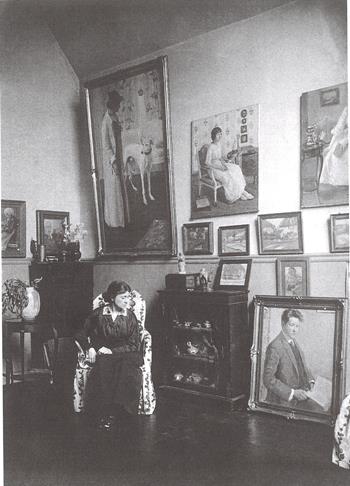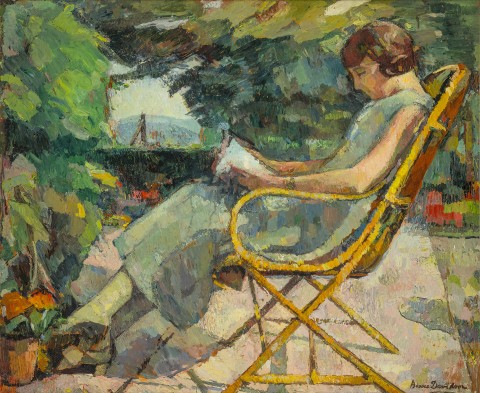LECTURE AU JARDIN, c.1935
BESSIE DAVIDSON
oil on plywood
94.0 x 114.0 cm
signed lower right: Bessie Davidson
Private collection, Normandy, France
Ornes Enchères, Alençon, France, 31 May 2014, lot 11 (as ‘La lecture au jardin’)
Private collection, United Kingdom
Daguerre Auctions, Paris, 27 May 2015, lot 252 (as ‘Femme à la chaise longue’)
Lauraine Diggins Fine Art, Melbourne
Justin Miller Art, Sydney
Private collection, New South Wales
Collectors’ Exhibition, Lauraine Diggins Fine Art, Melbourne, 6 August – 29 October 2016, (illus. in exhibition catalogue, pp. 46 – 7)
Bessie Davidson & Sally Smart – Two artists and the Parisian avant–garde, Bendigo Art Gallery, Victoria, 20 March – 26 July 2020
Curtin, P., (ed.), Bessie Davidson: An Australian Impressionist in Paris, Bendigo Art Gallery, Victoria, 2020, illus. front cover, pp. 45, 64 and illus. front cover
210688 Bessie Davidson in her Montparnasse Studio.jpg

Bessie Davidson’s paintings have an engaging French accent, Gallic in mood and sophistication. Her still lifes, such as Autumn Table at Villeneuve, c.1938 (private collection), express the pleasures of food and wine, of seasonal tables abundant with fruits and flowers. Interiors are feminine and domestic, intimately reflective of those who live in them, while figures are elegantly at ease, attired in light colours of lively of texture. In her recent essay on Davidson, Tansy Curtin wrote: ‘Davidson’s depictions of women at leisure are perhaps the most intriguing and revealing of all her works. These women appear passive, not actively engaged with the viewer’.1
Davidson was born in Adelaide and studied under Margaret Preston (then Rose McPherson), first visiting Paris with her in 1904. Attending the Académie de la Grande, she exhibited in the Salon de la Société des Artistes Français and the Societe des Beaux-Arts. Although returning to Adelaide in 1906, four years later she finally settled in Paris. Her apartment on the Rue Boissonade, Montparnasse became her home and studio. Like Rupert Bunny, her countryman, she exhibited regularly in Paris, gaining much critical recognition.
With ever-deepening French connections, Davidson’s life-long love is reflected in her numerous activities, associations and awards. Working as a nurse during World War I, in 1931 she was made a Chevalier de la Légion d’Honneur for art and humanity. The first Australian woman so honoured, she was also the first to be elected to the Société Nationale des Beaux-Arts. A foundation member of the Salon des Tuileries and the Société Nationale des Indépendants, in 1930 she became Vice-President of the Société Nationale de Femmes Artistes Modernes. Although she loved France, like Bunny, she never gave up her Australian citizenship.
The profiling of figures, seated indoors or in quiet, sunlit gardens, interested Davidson throughout her life in paintings characterised by the interplay of textured surfaces and pictorial illusions of depth. Fine examples include A French Interior, 1911 and Mother and Child, 1914, both in the collection of the Art Gallery of South Australia, Adelaide. Together with Lecture au Jardin, (Reading in the Garden), c.1935, each shares eye-catching figures and their gentle curves of relaxation.
Recording the visual pleasures of the everyday with the light-filled verve of French Impressionism, Davidson later developed a more prominent sense of form and compositional structure allied to Paul Cézanne and Post Impressionism. It is this ‘Cézannesque’ style, which Davidson’s biographer, Penelope Little, describes as characterising ‘her most confident and productive years’.2 Celebrated in Lecture au Jardin, its brushwork is full of variety, with both vertical and horizontal strokes creating a fascinating picture surface. Images morph into the formal elements of painting - composition, colour, form and texture. Bathed in entrancing light, colours of subtle combination and harmonies of powerful diagonals beguile as one is drawn through the trees into the landscape beyond. Growing in self-assurance, Davidson moved more towards the semi-abstract from the 1920s onwards. A ready illustration of this transition is provided by comparing Femme au Canapé Rayé, 1919 (private collection)3 with the work on offer, and the closely related sundrenched, La Robe Jaune (The Yellow Dress), 1931 (private collection, Sydney).
Acquired by the prestigious Musée d’Art Moderne, Musée d’Orsay and the Musée du Petit Palais, in Paris, in 1999 the Australian Embassy, Paris, presented the exhibition, Bessie Davidson: Une Australienne en France, 1880-1965. And last year, the Bendigo Art Gallery staged Bessie Davidson & Sally Smart – Two artists and the Parisian avant-garde, which included Lecture au Jardin.
Many years ago, a correspondent wrote from London that Bessie Davidson holds: ‘a distinguished position in the art world, perhaps the most gifted of Australian women painters’.4
1. Curtin, T., ‘Bessie Davidson: Painter of domestic avant-garde’, in Bessie Davidson: An Australian Impressionist in Paris, Bendigo Art Gallery, Victoria, 2020, p. 13
2. Little, P., A Studio in Montparnasse; Bessie Davidson: An Australian in Paris, Craftsman House, Melbourne 2003, p. 87
3. Ibid., p. 179 (illus.)
4. ‘Letter from London: Miss Davidson succeeds’, News, Adelaide, 12 March 1929, p. 6. cited in Curtin, op.cit., p. 11
DAVID THOMAS
